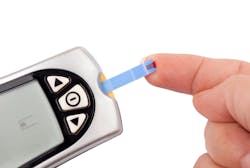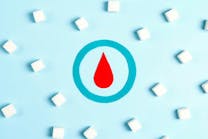Blood glucose testing in hospitals using point-of-care testing (POCT) devices has been a mainstay of glycemic control for decades, and the benefits of this are well documented and recognized by patients, providers, and laboratory professionals. POCT measurement of ketones is a more recent development and is the next logical step in managing patients with diabetes in the hospital. Measuring ketones goes hand in hand with hyperglycemia, and POCT ketone testing confers the same advantages as it does for glucose: rapid, accurate results with the ability to make treatment decisions in real time.
Ketone physiology and diabetic ketoacidosis
Ketone metabolism and physiology is quite complex, but at its simplest level, ketones are produced when the body utilizes fat for energy production. The most serious and common example of this is diabetic ketoacidosis (DKA), where there is insufficient insulin to allow for proper glucose entry into cells. DKA is more common in type-1 diabetics but occurs in type-2 diabetics as well. It can be the presenting sign of new onset diabetes but can also develop from poor compliance with an insulin regimen, or from a coexisting illness such as infection, trauma, coronary syndrome, or surgery. Less common causes of ketosis or ketoacidosis may include a low-carbohydrate (“keto”) diet, excessive alcohol use, and starvation. DKA is far more likely to be seen in hospitals than any of the other conditions and while mortality from DKA is decreasing, the incidence is increasing.1,2
When there is insufficient insulin or inadequate glucose (at the cellular level these are indistinguishable), the body “thinks” it is being starved, and a series of metabolic processes swing into action to allow for alternate energy production. These include increased glucagon production, which stimulates glucose production from glycogen in the liver and peripheral breakdown of triglycerides, increased lipase production to break down fat, and an increase in stress hormones such as cortisol and catecholamines. This starts a cascade of lipolysis where triglycerides are broken down into free fatty acids, glycerol, acetyl CoA, and ketones, which consist of beta-hydroxybutyrate (BHB), acetoacetate (AA), and acetone.3,4 BHB accounts for roughly 80% of ketones in humans, and its production is useful because it is one of the few substances, other than glucose, which can be used by the brain as a fuel source. Acetone is excreted in the lungs and gives the breath a characteristic fruity odor. If this process goes unchecked, severe acidosis ensues, and is a potentially life-threatening condition that needs immediate treatment and close monitoring.
Diagnosing DKA
As its name implies, diagnosing DKA was traditionally based on an elevated blood glucose (> 250 mg/dL) (“diabetic”), positive ketones in either the blood or urine (“keto”), and acidosis either based on measuring pH or serum bicarbonate(“acidosis”). Recently, however, there has been a rise in so-called “euglycemic” DKA, where the blood glucose is normal, which is commonly seen in patients taking a class of medications known as SGLT2 inhibitors. A recent consensus statement from leading diabetic management groups in the United States has defined DKA as any elevation of serum or urine ketones above the upper limit of normal, and either a pH < 7.3 or serum bicarbonate < 15 mmol/L.5 Other guidelines still require an elevated glucose and require a BHB level of > 3 mmol/L,6 in addition to acidosis.
Regardless of the fine points of diagnosis, measuring ketones is key to identifying and treating DKA. Ketones can be measured in the blood or urine. Urine ketones are measured qualitatively using the nitroprusside method with a dipstick. This may be adequate for screening a patient with suspected DKA but has several limitations: the nitroprusside method only measures AA and acetone and not BHB; AA levels may actually remain elevated for up to 48 hours after BHB levels decline, giving a false sense of persistent DKA; measuring ketones in the urine can reflect a state of ketosis from several hours prior, as urine can dwell in the bladder for long periods of time in DKA due to dehydration; and the measure is qualitative and subjective, based on a color change in the strip. Thus, it is recommended that urine ketone testing only be used for screening purposes and any positive should be verified in blood. Urine ketone testing is not acceptable for monitoring DKA treatment.6,7 Some laboratories still use the nitroprusside test for ketones in the blood—a College of American Pathologists survey in 2020 found that roughly one-third of laboratories were using this method (840/2625 labs).7 This testing, for the reasons noted above, is less ideal than direct testing for BHB, which is done by POC meters, and by most labs. Early diagnosis of DKA is now feasible using POC technology, and this can be used in the prehospital or emergency department setting to initiate treatment, rather than waiting for central laboratory testing.8,9 The ability to rapidly diagnose ketosis and DKA in an unwell diabetic patient allows for prompt initiation of therapy, and this is best done using POCT. Having the ability to measure glucose and ketones with a single meter allows for instantaneous reflex testing for ketones in anyone with an elevated blood sugar.
Treating and monitoring DKA
The mainstays of DKA treatment are insulin and fluid administration and monitoring laboratory values, especially glucose and ketone levels, as well as pH and electrolytes.6,10 Although it does not appear that absolute levels of BHB correlate with the severity of DKA, most guidelines recommend that BHB levels be monitored to assess the success of treatment. The American Diabetic Association recommends monitoring until the ketonemia is controlled but doesn’t specify a frequency.11 More recent guidelines from the Joint British Diabetes Societies recommend use of POCT for BHB measurement, and to aim for a reduction in BHB concentration of 0.5 mmol/L/hr.10 Likewise, the International Society for Pediatric and Adolescent Diabetes also recommends POCT be used for BHB measurement when available, and that the BHB level should be checked every 2 hours until the level is less than 1 mmol/L.12 This group also recommends a target reduction of 0.5 mmol/L/hr.
Since glucose measurement is also done frequently in DKA (typically every 1–2 hours), and done using POCT, it makes logical and practical sense to have a combined device for testing both ketones and glucose, and such devices exist.13 This makes assessing the effectiveness of treatment fast and allows immediate adjustment of treatment regimens, rather than waiting for a central laboratory result. Almost all POC ketone meters measure BHB directly, so that results are quantitative, and some of these devices have been shown to have good analytical performance compared with central laboratory.14
Although handheld meters to measure ketones are available for self-testing, it is important to learn the lessons from self-testing glucose meters. It has long been known that hospitalized patients are a more complex and heterogeneous group than those at home, with potential for interference of accurate measurement from endogenous sources (e.g., hematocrit, pH) and exogenous sources (medications such as acetaminophen and vitamin C) with glucose meters. These same interferences can, and do, affect some POCT ketone devices.13 In fact, there is only one glucose meter cleared by the U.S. Food and Drug Administration (FDA) for use in all hospitalized, mainly due to a lack of demonstrated interferences.15 The technology used in this device is also available for ketone measurement in a combined meter, although its FDA ketone clearance status is pending as of the date this article was written. Since not all POC meters are created equally, it is imperative to choose a POC device wisely, and with knowledge of potential risks for errors.3,13,14
References
1. Benoit SR, Zhang Y, Geiss LS, Gregg EW, Albright A. Trends in Diabetic Ketoacidosis Hospitalizations and In-Hospital Mortality - United States, 2000-2014. MMWR Morb Mortal Wkly Rep. 2018;30;67(12):362-365. doi:10.15585/mmwr.mm6712a3.
2. Desai D, Mehta D, Mathias P, Menon G, Schubart UK. Health Care Utilization and Burden of Diabetic Ketoacidosis in the U.S. Over the Past Decade: A Nationwide Analysis. Diabetes Care. 2018;41(8):1631-1638. doi:10.2337/dc17-1379.
3. Dhatariya K. Blood Ketones: Measurement, Interpretation, Limitations, and Utility in the Management of Diabetic Ketoacidosis. Rev Diabet Stud. 2016;13(4):217-225. doi:10.1900/RDS.2016.13.217.
4. Gosmanov AR, Gosmanova EO, Kitabchi AE, et al. Hyperglycemic Crises: Diabetic Ketoacidosis and Hyperglycemic Hyperosmolar State, in Endotext [Internet], A.B. Feingold KR, Blackman MR, et al., Editor. 2021, MDText.com, Inc. p. 1-30.
5. Agiostratidou G, Anhalt H, Ball D, Blonde L, et al. Standardizing Clinically Meaningful Outcome Measures Beyond HbA1c for Type 1 Diabetes: A Consensus Report of the American Association of Clinical Endocrinologists, the American Association of Diabetes Educators, the American Diabetes Association, the Endocrine Society, JDRF International, The Leona M. and Harry B. Helmsley Charitable Trust, the Pediatric Endocrine Society, and the T1D Exchange. Diabetes Care. 2017;40(12):1622-1630. doi:10.2337/dc17-1624.
6. Dhatariya KK, Glaser NS, Codner E, Umpierrez GE. Diabetic ketoacidosis. Nat Rev Dis Primers. 2020;14;6(1):40. doi:10.1038/s41572-020-0165-1.
7. Kilpatrick ES, Butler AE, Ostlundh L, Atkin SL, Sacks DB. Controversies Around the Measurement of Blood Ketones to Diagnose and Manage Diabetic Ketoacidosis. Diabetes Care. 2022;1;45(2):267-272. doi:10.2337/dc21-2279.
8. Prothero L, Foster T, Dhatariya K, et al. PP37 Use of capillary blood ketone meters to improve ambulance service care of hyperglycaemic patients: protocol for a stepped-wedge, controlled feasibility study (KARMA2). Emerg Med J. 2021;38(9):A15.3-A16. doi:10.1136/emermed-2021-999.37.
9. Bektas F, Eray O, Sari R, Akbas H. Point of care blood ketone testing of diabetic patients in the emergency department. Endocr Res. 2004;30(3):395-402. doi:10.1081/erc-200035231.
10. Dhatariya KK, Joint British Diabetes Societies for Inpatient Care. The management of diabetic ketoacidosis in adults-An updated guideline from the Joint British Diabetes Society for Inpatient Care. Diabet Med. 2022;39(6):e14788. doi:10.1111/dme.14788.
11. Kitabchi AE, Umpierrez GE, Miles JM, Fisher JN. Hyperglycemic crises in adult patients with diabetes. Diabetes Care. 2009;32(7):1335-43. doi:10.2337/dc09-9032.
12. Wolfsdorf JI, Glaser N, Agus M, Fritsch M, et al. ISPAD Clinical Practice Consensus Guidelines 2018: Diabetic ketoacidosis and the hyperglycemic hyperosmolar state. Pediatr Diabetes. 2018;19 Suppl 27:155-177. doi:10.1111/pedi.12701.
13. Ceriotti F, Kaczmarek E, Guerra E, Mastrantonio F, Lucarelli F, Valgimigli F, Mosca A. Comparative performance assessment of point-of-care testing devices for measuring glucose and ketones at the patient bedside. J Diabetes Sci Technol. 2015;9(2):268-77. doi:10.1177/1932296814563351.
14. Vandamme S, Van Mechelen K, Cluckers H, Van Hoof V. Validation of the Nova point-of-care testing StatStrip β-ketone test in a laboratory and clinical setting. Point Care. 2018;17(1):13-14. doi:10.1097/poc.0000000000000155.
15. StatStrip and StatStrip Xpress®2 Glucose Meters-Only glucose meters accurate enough to be FDA cleared for use with ALL patients, including critically ill. Novabiomedical.com. Accessed April 14, 2023. https://www.novabiomedical.com/statstrip-glu/.





